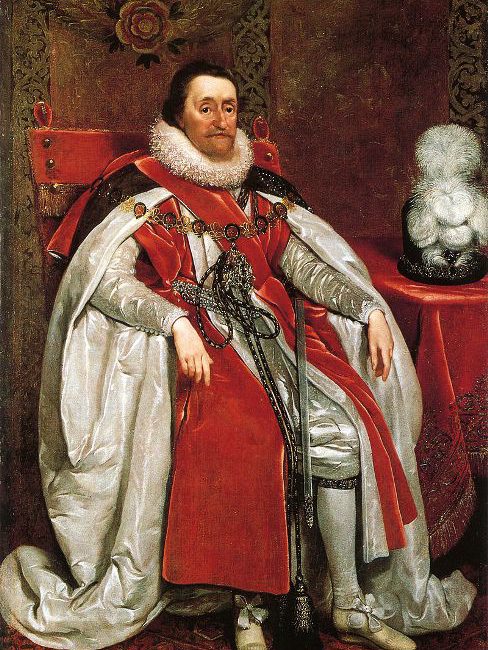One of my readers asked me a question what I think about Mary Queen of Scots “getting the last laugh” over Queen Elizabeth I because Mary’s son James became the king, even though Elizabeth ordered Mary’s death. Therefore, I feel obliged to write this post, as I absolutely disagree with this reader, of course respectfully.
It is true that the Stuarts ruled England for a few centuries after James, the only son of Mary Queen of Scots and Henry Stuart, Lord Darnley, became King of England after Queen Elizabeth I’s death.

In Scotland, James was known as “James the sixth, King of Scotland”, until 1604. Immediately after Elizabeth I’s death, James was proclaimed “James the first, King of England, France and Ireland, defender of the faith” in London on the 24th of March 1603. In total, four Stuart king ruled Britain, with the exception of the parliamentary rule lasting from 1649 to 1660 as a result of the English Civil War. In the Stuart era, following the Glorious Revolution in 1688, there were also two Stuart queens – Mary II and Anne. Then, under the terms of the 1701 Act of Settlement and the 1704 Act of Security, the crown of England passed from the House of Stuart to the House of Hanover.
Throughout her life, Elizabeth refused to nominate her heir, explaining that she didn’t want to do that because she believed that it would elicit disaffection of the English people towards her. In reality, the queen understood very well that naming her successor would instantly make a nominated person a threat to her rule as the said person might try to arrange her premature death, and she coveted to avoid additional tension and danger. During Elizabeth’s reign, the succession was the subject of much debate for decades.

Although the dynastic position of the House of Tudor was not clarified, James I of Scotland was the obvious candidate to be Elizabeth’s successor – he was the son of two grandchildren of Margaret Tudor and blood claim was strong. However, there was another claimant from the House of Stuart – Lady Arbella Stuart, the daughter of one of Margaret’s grandsons.
There was the Lennox claim: Lady Margaret Douglas, Countess of Lennox, wasn’t nominated by the dying Mary I as her successor, but later she nevertheless became a figure in discussions of the succession. There were also the Suffolk claimants, but they weren’t as powerful as other claimants: Lady Mary Grey lacked interest in royal pretensions, whereas Lady Eleanor Clifford’s family was more often talked of in relation to the succession. But all of the Suffolk claimants couldn’t garner as much support as the Stuarts did.

Arbella Stuart might have become Elizabeth’s successor, but it seems that Elizabeth didn’t consider her as her probable heir. There were discussions of good marriages for her throughout Arbella’s childhood: it would have suited the Roman Catholic Church for her to marry a member of the House of Savoy and then take the English throne. In the last months of Elizabeth’s reign, Arbella landed into trouble because rumours about her probable marriage to Edward Seymour began to circulate, and Elizabeth learnt that. Personally, I don’t think that it had any impact on the probability of Arbella taking the throne after Elizabeth’s death – that probability was always quite low.
In the last years of Elizabeth’s life, discussion of the succession was strongly discouraged and even became dangerous. Accordance with the queen’s order, the Privy Council was pro-active against pamphlets and privately circulated literature on the topic, withdrawing it from the society and punishing the creators. The aging queen probably didn’t tolerate the topic of her possible departure from earth; by feeling that way and banning the topic of succession, she also ensured that she could live her last years in calmness.

Out of all the claimants, King James I, Mary Stuart’s son, was the most probable candidate for succession. The execution of Mary Queen of Scots strengthened James’ position. I wouldn’t say that “Mary Queen of Scots had her last laugh only” because Elizabeth understood who would be her successor, even though she didn’t name him. Many English nobles looked to James I in the later years of Elizabeth’s life, but I can hardly believe that it was something new for Elizabeth. Elizabeth predicated that Mary’s son would become king and would unite Scotland and England then without bloody wars – I think she wanted that for the two countries.
William Cecil, 1st Baron Burghley, died in 1592, before Elizabeth I’s death, possibly a heart attack. Before he died, Sir Robert Cecil stepped into his shoes as the queen’s principal adviser, and it was Robert, not his father Cecil, who ensured James’ smooth accession to the throne after the queen’s passing.
Preparing for James’ succession, Cecil maintained a secret correspondence with the King of Scotland. When in March 1603 Elizabeth was dying, Cecil sent James a draft proclamation of his accession to the English throne. Robert Cecil achieved his goal: James’ succession was not only smooth, but it also brought hope, although the kingdom was mourning for Elizabeth. During his progress southwards from Edinburgh to London, James was also met everywhere with gladness and joy as lords received him with lavish hospitality and swore their fealty to him. Yet, the people missed Elizabeth greatly for a long time.





